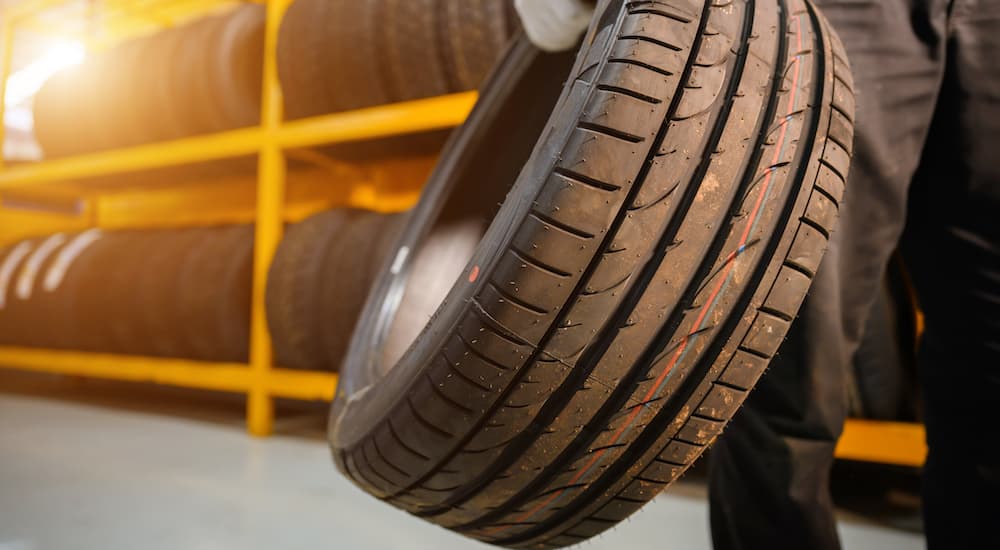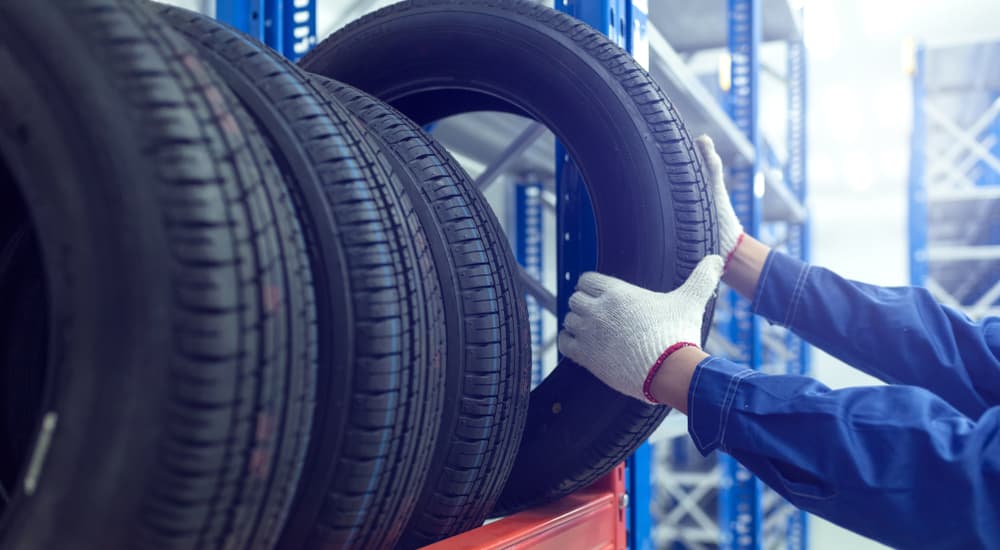Choosing the right set of tires at your local tire shop can make all the difference when it comes to outfitting your vehicle for certain applications. Are you looking to conquer your local off-road trails? A good set of all-terrain or mud-terrain tires will go a long way toward ensuring consistent traction when you need it most. Want to get the most out of your souped-up sports car? There’s no beating the sort of grip that summer performance tires can provide. If efficiency is your main concern, look no further than low rolling resistance tires. Designed to maximize fuel economy, low rolling resistance (LRR) tires can maintain the same speed as your run-of-the-mill tires with less force. This can lead to some real savings at the pump, not to mention the potential environmental benefits. What is rolling resistance, what attributes separate LRR tires from the rest of the pack, and how much value can they offer the average driver?
What Is Rolling Resistance?
Before we dive into the finer details of LRR tires, let’s take a moment to review the concept of rolling resistance. In the simplest terms, rolling resistance is just the amount of force that’s needed to keep a vehicle’s wheels moving at a certain speed. Tires might all look the same from a distance, but when they’re in motion, they’re actually deforming and compressing more than a driver might realize. The more a tire deforms during operation, the more power that’s needed to keep it moving. All tires aren’t created equal when it comes to rolling resistance, with softer tires or those with aggressive tread patterns requiring more force than those with a harder design or smoother tread patterns.
The US Energy Information Agency has found that a ten percent reduction in rolling resistance can improve a vehicle’s overall fuel economy by between one and two percent. Every time you step on the gas, all of the power being produced by your vehicle’s engine isn’t making it to the road itself. According to some estimates, the amount of power reaching the wheels can be 20 to 40 percent lower than a vehicle’s advertised horsepower. Where is all this energy going? From the transmission and differentials to the driveshaft, tires, and the energy sacrificed to wind resistance and inertia, a lot of this power simply gets lost in translation. Tires are actually one of the biggest culprits, eating up between four percent of the vehicle’s energy when driving around town and as much as seven percent on the highway. The Department of Energy says that rolling resistance alone can account for four to 11 percent of a vehicle’s fuel consumption, a figure that illustrates just how important selecting the right set of tires can be.
What Makes a Tire Low Rolling Resistance?
Five main factors make a low rolling resistance tire a more efficient choice than standard tires. From tread design and sidewall stiffness to the tire’s weight, the size of its contact patch, and the specific compound used in its construction, these five features all play a pivotal role in keeping your tires rolling down the road as efficiently as possible. Let’s take a closer look at each of these factors and see how LRR tires differ from their gas-guzzling cousins.
Tread Design
A bulky, aggressive tread pattern is a good thing if you’re trying to chew your way through mud, sand, or other loose surfaces. These designs tend to maximize traction, but that does come at the direct cost of efficiency. The knobby tires found on off-road vehicles create a lot of resistance, and the engines work to overcome their oversized tread blocks.
The principle is easy to understand in theory but can be a little more difficult to wrap your mind around due to the fact that drivers don’t tend to realize how much energy is being expended when they step on the gas pedal. Instead, imagine you’re riding a bicycle. A mountain bike with aggressive off-road tires will take a lot more energy to push down the road than a road bike riding on a smooth racing tire with little, if any, tread. The same is true when it comes to your vehicle’s tires. LRR tires feature a more minimalist tread pattern and a more connected design without any of the large gaps found in a set of all-terrain or mud-terrain tires. This design allows the tires to seamlessly glide across the asphalt, maximizing fuel economy and making a gentler, quieter ride all around.
Tread Compound
The rubber compound used to create a set of tires can also greatly impact fuel economy. Softer, squishier tires are great for grip, but the harder a compound with less give is the way to go when you’re trying to achieve the best possible gas mileage. Not only do they not deform as much as softer tires, but their reduced grip on the road requires less power to keep them turning. Harder tires also tend to stay cooler, which means that less energy is being sacrificed in the form of heat.
Sidewalls
The tread compound isn’t the only factor that determines how stiff a given set of tires is going to be. The sidewalls also affect how much resistance a tire will face. Softer sidewalls are more prone to deforming as you roll down the road, while stiffer sidewalls resist this sort of distortion. Again, a bicycle-based analogy can be helpful. Underinflated tires will spread out where they make contact with the road and force you to work harder at pumping the pedals. A set of tires that have been inflated to the proper pressure will retain their shape and keep you rolling right along.
Contact Patch
The skinnier the tire, the more efficient it can be. The amount of effort the engine has to put in is directly proportional to how much surface area a tire has, which is why narrower designs are such an important part of the LRR tire equation. A tire that’s six inches wide will consume 40 percent less power than a ten-inch wide tire. Of course, you can only go so slim before it starts to affect a vehicle’s performance and safety. That’s why extremely narrow space-saver spare tires are only recommended for temporary use to get to a tire shop.
Weight
Drivers don’t often stop to consider the weight of their tires and the effect it can have on overall efficiency. A vehicle’s unsprung weight describes the total weight of its tires, wheels, brakes, and suspension, while sprung weight represents the mass that’s supported by the suspension. Reducing a vehicle’s unsprung weight has more of an effect on rolling resistance than sprung weight, which is why LRR tires are often designed to be as light as possible.
How Much Money Do They Save?
LRR tires do tend to be a little more expensive than their conventional counterparts. A set of conventional tires averages around $400, while the typical LRR tires will set you back about $500. This difference is easily covered when you factor in the potential fuel savings. If a set of LRR tires can deliver a fuel savings of just two percent, a driver averaging 12,000 miles and 550 gallons of gas a year will save around $34 a year, assuming an average per-gallon gas price of $3.50. Assuming the tires last around 50 months, that represents a savings of about $140. That more than covers the initial purchase price of the LRR tires and has the added benefit of reducing a vehicle’s lifetime emissions. When all is said and done, LRR tires boast a total ownership cost that’s around eight percent less than conventional tires.
In a study conducted in 2019, Consumer Reports painted an even rosier picture of the LRR approach. The nonprofit consumer organization found a massive 34-percent gap between the best and worst-performing tires on the market when it came to rolling resistance, illustrating just how important a little pre-purchase research can be. Over the course of an average year behind the wheel, a driver logging 12,000 miles would save 14 gallons of gas by opting for the best LRR tire versus the tire with the highest rolling resistance. Assuming an average per-gallon price of $5, that would equate to $70 a year or $360 over a set of tires’ entire service life.
Downsides
The truth is, there aren’t many downsides to a LRR tire. When the technology was first introduced, LRR tires did require drivers to make some notable compromises when it came to factors like handling and ride comfort, but that’s becoming less true with every passing year. If there’s one major downside to LRR tires, it would have to be tread life. The same factors that help to improve a tire’s fuel efficiency also tend to reduce its service life, with LRR tires lasting an average of 50,000 miles versus 60,000 miles for traditional all-season tires. Drivers should also be a little more careful when they’re behind the wheel of a vehicle that’s rolling on LRR tires. While advancements have certainly been made, the narrower tread of an LRR tire means that it can’t offer the same stopping distance as a traditional tire. This is especially true when facing wet road conditions, which is why it’s so important always to give yourself a little extra room to stop and keep the tires at the correct pressure when opting for LRR products.
Low rolling resistance tires are nothing new, but they’ve become an increasingly popular option for one simple reason: EVs. Today’s EV manufacturers are leveraging every innovation under the sun in order to improve range, from regenerative braking and solar panels to aerodynamic designs and LRR tires. While they might be the EV segment’s go-to choice, every driver can benefit from a set of LRR tires. Sure, they may not be the ideal choice for off-road applications and harsh, wet weather or for drivers who plan on doing a lot of towing, but the average driver can put a noticeable dent in their monthly gas bill by investing in a set of LRR tires. Almost every manufacturer on the market now offers an LRR tire, from the Bridgestone Ecopia and Dunlop Enasave to the Michelin Energy Saver A/S All-Season and Firestone Champion Fuel Fighter. When it’s time to spring for your next set of tires, take a moment to consider the potential cost savings that LRR tires could offer.






